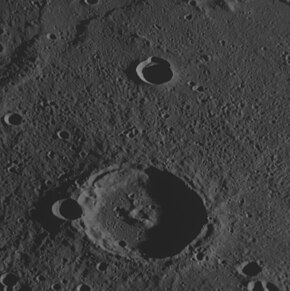
Airy-0 is a crater inside the larger Airy Crater on Mars, whose location defined the position of the prime meridian of that planet. It is about 0.5 km (0.3 mile) across and lies within the dark region Sinus Meridiani, one of the early albedo features to be identified on Mars. In 2018, the IAU Working Group on Cartographic Coordinates and Rotational Elements recommended setting the longitude of the Viking 1 lander as the reference line. This definition maintains the position of the center of Airy-0 at 0° longitude, within the tolerance of current cartographic uncertainties.

Stickney is the largest crater on Phobos, which is a satellite of Mars. It is 9 km (5.6 mi) in diameter, taking up a substantial proportion of the moon's surface.

Chao Meng-Fu is a 167 km (104 mi) diameter crater on Mercury named after the Chinese painter and calligrapher Zhao Mengfu (1254–1322). Due to its location near Mercury's south pole and the planet's small axial tilt, an estimated 40% of the crater lies in permanent shadow. This combined with bright radar echoes from the location of the crater leads scientists to suspect that it may shelter large quantities of ice protected against sublimation into the near-vacuum by the constant −171 °C (−276 °F) temperatures.
As-Samaw’al bin ‘Ādiyā’ was a pre-Islamic Arabian poet and warrior, esteemed by the Arabs for his loyalty, which was commemorated by an Arabic idiom: "awfá min as-Samaw’al".

The Memnonia quadrangle is one of a series of 30 quadrangle maps of Mars used by the United States Geological Survey (USGS) Astrogeology Research Program. The Memnonia quadrangle is also referred to as MC-16.

Newton is a large crater on Mars, with a diameter close to 300 km. It is located south of the planet's equator in the heavily cratered highlands of Terra Sirenum in the Phaethontis quadrangle. The crater was named in 1973 by the International Astronomical Union (IAU) Working Group for Planetary System Nomenclature (WGPSN) in honor of British physicist Sir Isaac Newton.
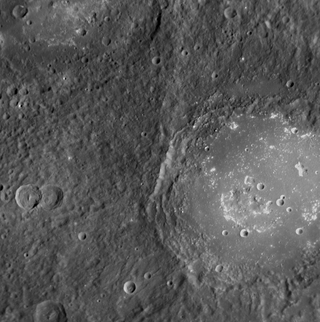
Lermontov is an impact crater on the planet Mercury. The crater is named after Mikhail Yuryevich Lermontov, a 19th-century Russian poet. The name was approved by the International Astronomical Union in 1976.

Tir Planitia is a large plain on the planet Mercury. The name Tir (تیر) is the Persian word for "Mercury",, and the name was approved in 1976. It was first observed in detail by Mariner 10. It lies between the large crater Mozart and the ancient Tolstoj basin.
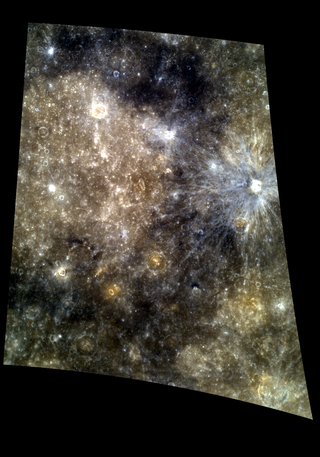
Tolstoj is a large, ancient impact crater on Mercury. It was named after Leo Tolstoy by the IAU in 1976. The albedo feature Solitudo Maiae appears to be associated with this crater.

Hun Kal is a small crater on Mercury that serves as the reference point for the planet's system of longitude. The longitude of Hun Kal's center is defined as being 20° W, thus establishing the planet's prime meridian. The name "Hun Kal" means '20' in the language of the Maya.

Bashō is a crater on Mercury named after Matsuo Bashō, a 17th-century Japanese writer. Bashō crater is only 74.62 kilometers (46.37 mi) in diameter, but is a prominent feature on Mercury's surface, due to its bright rays. Photographs from NASA's Mariner 10 and MESSENGER spacecraft show a curious halo of dark material around the crater.

Verdi is an impact crater on the planet Mercury. It was named after Italian Romantic composer Giuseppe Verdi (1813–1901) in 1979, as recognized by the International Astronomical Union. The crater's extensive ejecta blanket and secondary crater field are superposed on plains materials and older craters.
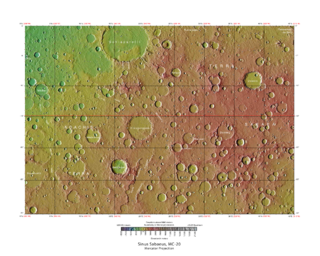
The Sinus Sabaeus quadrangle is one of a series of 30 quadrangle maps of Mars used by the United States Geological Survey (USGS) Astrogeology Research Program. It is also referred to as MC-20 . The Sinus Sabaeus quadrangle covers the area from 315° to 360° west longitude and 0° to 30° degrees south latitude on Mars. It contains Schiaparelli, a large, easily visible crater that sits close to the equator. The Sinus Sabaeus quadrangle contains parts of Noachis Terra and Terra Sabaea.

Gibran is a crater on Mercury and is in the east of the Shakespeare quadrangle. It was named after Lebanese-American poet Khalil Gibran in 2009. Gibran is located east of the rayed crater of Degas and nearby Damer.
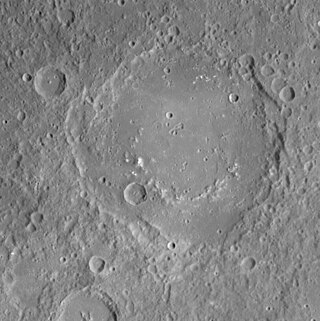
Al-Hamadhani is a crater on Mercury. It has a diameter of 186 kilometers. Its name was adopted by the International Astronomical Union in 1979. Al-Hamadhani is named for the Iranian writer Badi' al-Zaman al-Hamadani, who died in 1007 C.E.
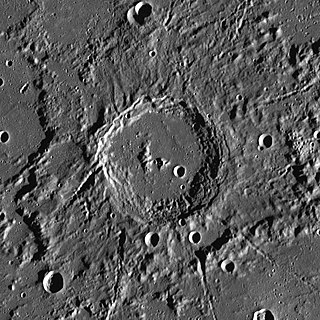
Mansur is a crater on Mercury. Its name was adopted by the International Astronomical Union in 1979. Mansur is named for the Indian artist Ustad Mansur, who lived in the 17th century CE.

Elysium Planitia, located in the Elysium and Aeolis quadrangles, is a broad plain that straddles the equator of Mars, centered at 3.0°N 154.7°E. It lies to the south of the volcanic province of Elysium, the second largest volcanic region on the planet, after Tharsis. Elysium contains the major volcanoes Elysium Mons, Albor Tholus and Hecates Tholus. Another more ancient shield volcano, Apollinaris Mons, is situated just to the south of eastern Elysium Planitia. Within the plains, Cerberus Fossae is the only Mars location with recent volcanic eruptions. Lava flows dated no older than 0.2 million years from the present have been found, and evidence has been found that volcanic activity may have occurred as recently as 53,000 years ago. Such activity could have provided the environment, in terms of energy and chemicals, needed to support life forms.
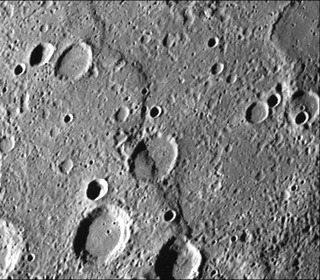
Inter-crater plains on Mercury are a land-form consisting of plains between craters on Mercury.

Hipparchus is an impact crater in the Phaethontis quadrangle of Mars, located at 44.8° S latitude and 151.4° W longitude. It is 93 kilometers in diameter. It was named after the ancient Greek astronomer Hipparchus in 1973.
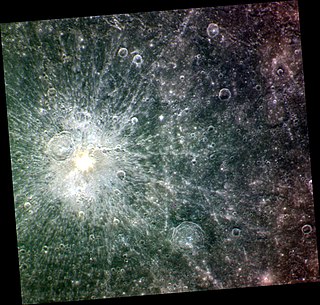
Nureyev is a crater on Mercury. It has a diameter of 16 kilometers, and has a bright and extensive ray system. Its name was adopted by the International Astronomical Union (IAU) on April 24, 2012. Nureyev is named for the Soviet and British ballet dancer Rudolf Nureyev.
